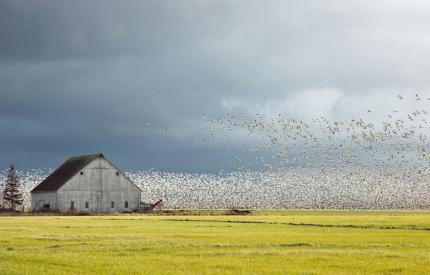
Washington hunters have harvested about 430,000 ducks and 72,000 geese during each of the past five years, and every county in the state was represented in those harvest figures. However, some areas of the state stand head and shoulders above the others in terms of waterfowl harvest.
Grant County is traditionally eastern Washington’s top duck producer, averaging just under 70,000 birds harvested annually. Yakima County is a distant second at 30,000 ducks a year, followed by Benton (25,000), Franklin (23,000), and Walla Walla (19,000) counties. West of the Cascades, Skagit County hunters take about 50,000 ducks a year, followed by Whatcom (26,000), Snohomish (23,000), Grays Harbor (16,000), and Clark (12,500) counties.
Grant County is also the state’s top goose-hunting spot, with an average annual harvest of more than 17,000 birds. Other top goose-producing counties are Franklin (7,300), Benton (5,700), Skagit (5,400), Yakima (3,500), Walla Walla (3,200), and Spokane (3,000) counties.
Information about duck and goose harvest figures for all Washington counties can be found under the annual small game harvest reports.
Public land access
There are a number of options available to duck and goose hunters on public land in Washington. Washington Department of Fish and Wildlife (WDFW) wildlife areas are good places to start, as are other state lands managed by the Department of Natural Resources.
Waterfowl hunting opportunities are also available on several National Wildlife Refuges and properties managed by the Bureau of Land Management. The Youth-Mentor hunts in late September provide great duck hunting opportunities for kids under the age of 16.
See the Hunt Planner webmap for details on these and other available waterfowl hunting areas.
Private land access
Through agreements with private landowners, WDFW has enrolled nearly one million acres in the Private Lands Access Program, which helps provide hunting opportunities on private land throughout the state.
Hunters can also do some scouting and door-pounding to get permission to hunt on other private lands. Landowner contact information is available through the county tax assessor office. Some landowners will refuse to grant hunting permission, but others will allow access, and hunters can make new friends along the way. Other options include hunt clubs and hiring a waterfowl guide who has access to private farms and ranches.
There are areas throughout the state off limits to hunters due to local and county shooting restrictions, which can identified by contacting your county sheriff’s office. Some areas are also closed by WDFW for resource management reasons. These are outlined in the WDFW waterfowl and big game pamphlets.
Additional hunt information
WDFW’s annual hunting prospects detail biologist expectations for hunting the upcoming seasons. The prospects are broken down in 17 districts, and should be the first place hunters go to research each year.
The purchase of a Washington hunting license includes a Vehicle Access Pass, which is all you need to utilize WDFW lands for hunting. It is also valid for hundreds of boat launches throughout the state. Boat launches on lakes and rivers can be a great way to explore un-tapped waterfowl hunting areas.